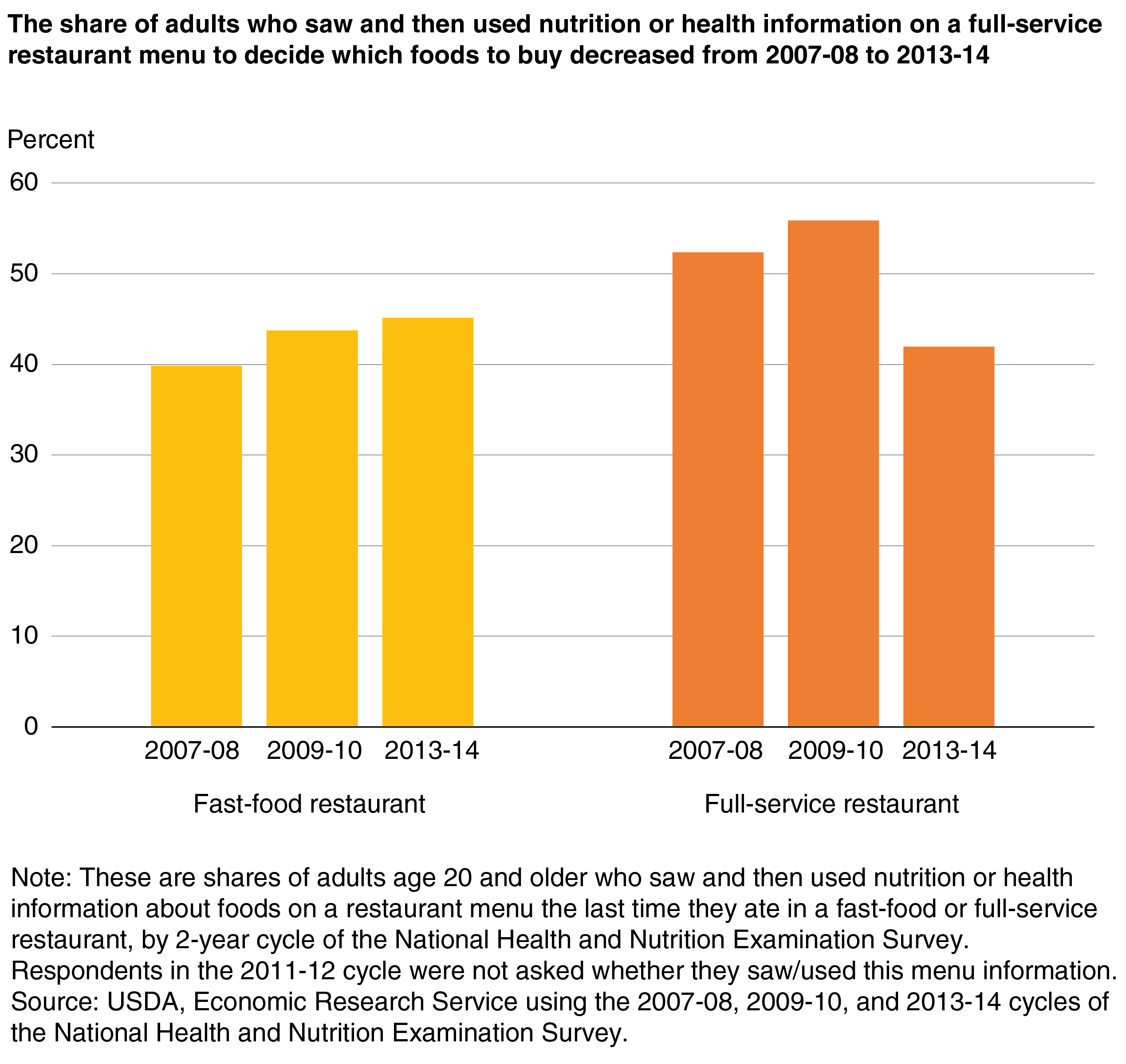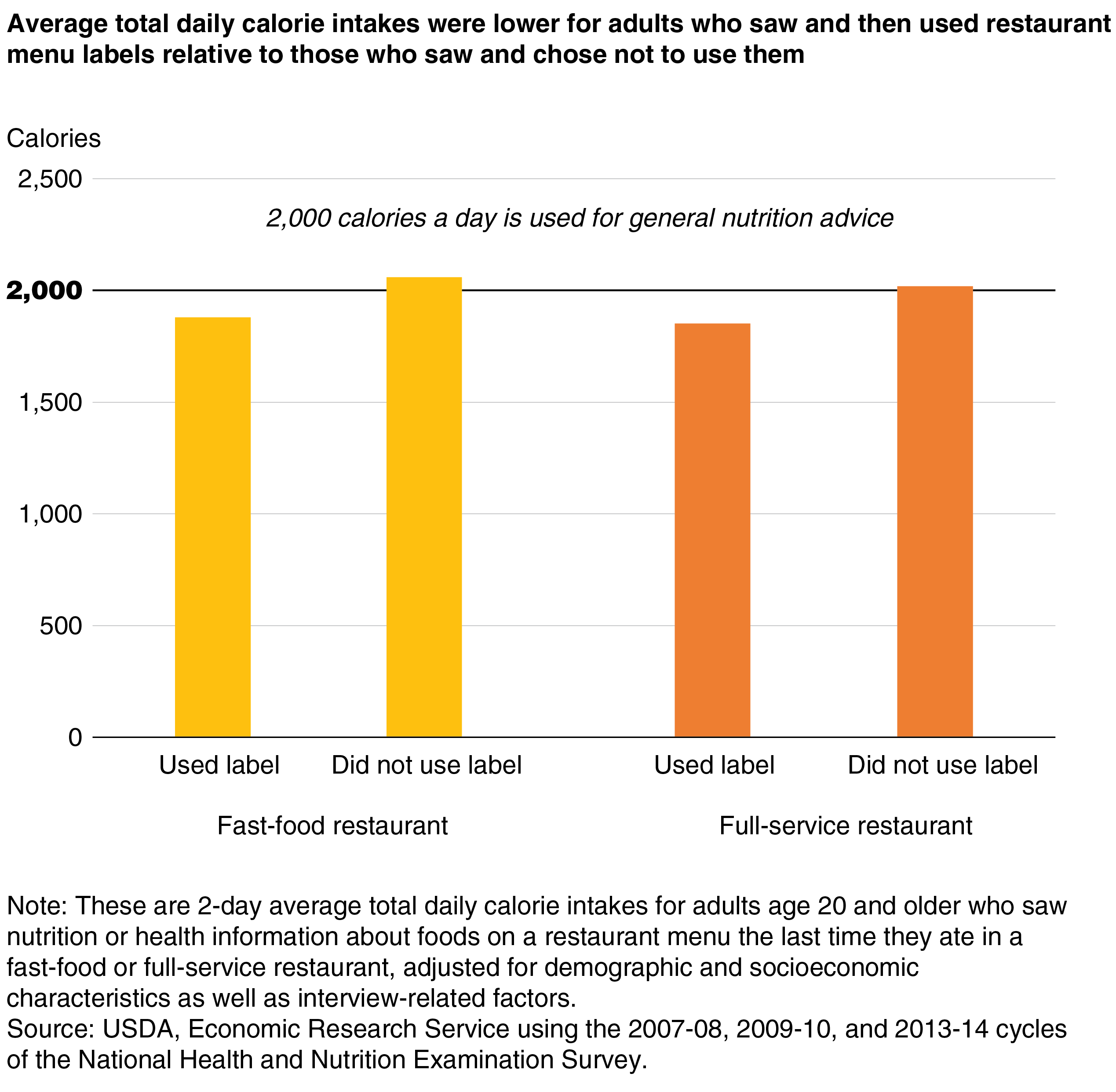
New National Menu Labeling Provides Information Consumers Can Use To Help Manage Their Calorie Intake
- by Brandon J. Restrepo and Travis Minor
- 10/31/2018
Highlights
- Newly implemented Federal regulations requiring chain restaurants and similar food service establishments to post the calorie contents of standard items on menus can help consumers better assess the healthfulness of restaurant foods.
- Analysis of 2007-14 data found that total daily calorie intakes were lower for consumers who saw and then used restaurant menu labels relative to those who saw but did not use them.
- While causality cannot be ascribed, full-service restaurant customers who used menu labels consumed 167 fewer total calories per day than did nonusers, and fast-food restaurant menu label users consumed 180 fewer total calories per day.
In May 2018, Federal regulations went into effect that are designed to help inform consumers about the calorie contents of the foods and beverages offered by many of the Nation’s restaurants. The regulations require restaurants and similar food service establishments that are part of a chain of 20 or more locations nationwide to post the calorie content of all standard items on menus in a font and format similar to that of the item’s price or name. To help consumers place the calorie information in the context of a total daily diet, covered establishments are also required to post on menus, or on a sign in close proximity to self-service foods, a statement that reads “2,000 calories a day is used for general nutrition advice, but calorie needs vary.” The regulations were set forth in the Patient Protection and Affordable Care Act of 2010 and finalized by the U.S. Food and Drug Administration (FDA) on December 1, 2014.
This point-of-purchase labeling expands consumers’ access to calorie information about the foods they order away from home. Before the Federal mandate, some food service establishments voluntarily provided calorie information to their customers, but mandatory disclosure was limited to a handful of cities, counties, and States. FDA estimated that the new menu labeling regulations would affect 298,600 retail food establishments, organized under 2,130 chains, in the United States. Using nationally representative data pertaining to a period before implementation of the new menu labeling regulations, a recent ERS study found that average total daily calorie intakes were lower for adults who saw and then used restaurant menu labels relative to those who saw and chose not to use them.
Nutrition Rules of Thumb Can Trip Up Consumers
Restaurants offer items with a range of calorie contents to cater to a wide array of consumer tastes and preferences. To get a sense of the average and range of calorie contents in restaurant meals, in a 2014 study, ERS researchers analyzed data on the amounts of calories in meals that were being offered at two fast-food and six full-service chain restaurants in Montgomery County, MD. Fast-food restaurants are eating places where consumers order and pay for food from a counter before eating. In full-service restaurants, wait staff take consumers’ orders for food at their tables and consumers pay after the meal is eaten.
The 2014 study found that fast-food meals (entrée and one side dish) contained between 215 and 1,710 calories, and full-service restaurant meals (entrée and standard side dishes) contained between 219 and 2,350. Full-service restaurant meals were often higher in calories (1,087, on average) than fast-food meals (726, on average). An average meal from either of these two types of restaurants accounts for a substantial share of the daily energy requirements of the 2,000-calorie reference diet—54 percent and 36 percent, respectively.
In the absence of point-of-purchase calorie counts, can meal attributes—such as whether a meal contains deep-fried items or is accompanied by creamy or buttery condiments and toppings—help consumers estimate a meal’s calorie content and identify lower calorie meals? ERS researchers showed in their 2014 study that, while such nutrition “rules of thumb” do help consumers distinguish between low- and high-calorie meals, they were less effective at helping diners pick up on differences of fewer than 200 calories. Moreover, these rules of thumb could potentially mislead consumers to make less healthy choices. For example, deep-fried foods at full-service restaurants were sometimes lower in calories than meals that had no deep-fried foods (e.g., a pasta dish). Additionally, considering a meal healthier just because it included a vegetable was not always true, as many of the highest calorie burgers and sandwiches came with lettuce and tomato. The study concluded that calorie information on menus can help Americans to better assess the healthfulness of restaurant foods and make finer adjustments to their food choices and behavior.
Local and State Laws Increased Consumers’ Exposure to Nutrition Information about Restaurant Foods
Prior to the May 2018 Federal menu-labeling regulations, some restaurants were providing calorie counts on their menus either voluntarily or in response to regulations implemented by local jurisdictions and a few States. A recent ERS analysis of National Health and Nutrition Examination Survey (NHANES) data found that the share of adults who saw nutrition or health information about foods on a fast-food restaurant menu increased from 21 percent in 2007-08 to 43 percent in 2013-14. Over the same time periods, the share of adults who saw such information on a full-service restaurant menu increased from 17 to 32 percent.
NHANES respondents were also asked if they used the nutrition information to decide which foods to buy while on the restaurant premises. From 2007-08 to 2013-14, the share of adults who saw and then used the nutrition information on a fast-food restaurant menu rose from 40 to 45 percent, though this change was not statistically significant. Over the same time periods, the share of adults who saw and then used nutrition information on a menu at a full-service restaurant decreased by 10 percentage points—from 52 to 42 percent. As consumers increase their knowledge of the calorie contents of foods through their exposure to menu labeling, they may be better able to decide what to order without using the calorie labels, especially if they generally go to the same restaurants when eating out. If there was such a “learning effect” among restaurant patrons in the 2007-08 to 2013-14 period, it may have been stronger in full-service restaurants than in fast-food restaurants.
Menu Labeling Can Help Inform Food Choices and Manage Daily Calorie Intake
While calorie information on restaurant menus is intended to influence food choices at the point of purchase, its impact could potentially extend to food choices and behavior throughout the day. Recent studies have begun to look at the total diet and longer term health effects of menu labeling on consumers, rather than the one-time effect of changing food orders on a restaurant’s premises. Once consumers are in a restaurant, they have likely committed to eating there and the presence of menu labels is unlikely to make them leave when they discover menu items have higher calorie counts than expected. It is likely that consumers will still order food from the restaurant; however, what happens after this transaction has not largely been explored. Perhaps, to compensate for indulging at the restaurant, individuals will have a lighter meal later in the day.
Additional analysis of NHANES data provides a starting point in answering the question of whether users of restaurant menu labels apply their improved knowledge of the calorie content of restaurant foods to help manage their calorie intakes. ERS researchers compared the average total daily calorie intakes of adults who saw nutrition information on a restaurant menu the last time they visited a restaurant and then used the information (“users”) to an arguably comparable group of adults, those who noticed the information but chose not to use it (“nonusers”). Calorie intake on a single day provides only a snapshot of consumers’ dietary behavior, so the analysis made use of an average of two self-reported, nonconsecutive, 24-hour dietary recall interviews in an effort to estimate more typical caloric intake. The researchers also controlled for demographic and socioeconomic characteristics as well as interview-related factors (e.g., whether an adult’s calorie intake information refers to a weekday or weekend).
The study was not designed to establish causality running from restaurant menu label use to total daily calorie intake. Instead, it demonstrated that restaurant menu label users consume fewer total calories per day than do nonusers, separate from demographic and socioeconomic characteristics as well as interview-related factors. The ERS researchers found that fast-food restaurant menu label users consumed about 180 fewer total calories per day than nonusers. They also found that the total daily calorie consumption of users of menu labels in full-service restaurants was lower by about 167 calories than that of nonusers.
Further analysis compared calorie intakes of restaurant menu label users and nonusers who reported eating food from fast-food or full-service restaurants during at least one of their dietary recall periods. Among adults who ate fast food, those who used fast-food menu labels consumed fewer calories than did nonusers from fast-food restaurants; grocery stores, supermarkets, and other food retailers; and food-away-from-home places other than fast-food and full-service restaurants. And among adults who ate food from a full-service restaurant, those who used full-service restaurant menu labels consumed fewer calories than did nonusers from full-service restaurants, fast-food restaurants, and other food-away-from-home places. These results suggest that the total daily energy intake gaps between menu label users and nonusers arise not only from food choices made in the restaurants that post nutrition information on menus but also from decisions made in grocery stores and supermarkets, as well as in other eateries that may not have had point-of-purchase nutrition information available.
While the ERS study was not designed to establish causality between restaurant menu label use and total daily calorie intake, a 2017 study of menu label effects in New York City did try to measure a causal link, in that case on the question of whether menu labeling can lead to lower total daily calorie intakes. The 2017 study analyzed whether implementation of local menu-labeling regulations was followed by a reduction in the average body weight of adults residing in jurisdictions that mandated menu labeling. A reduction in body weight could emerge as a result of a variety of reactions to the disclosure requirements by both consumers and the restaurant industry. For example, consumers may use the newly available information to substitute away from high-calorie meals while dining out. At the same time, restaurants may respond to the regulation by reformulating or resizing their offerings to reduce their calorie contents.
Starting in 2008, New York City mandated chain restaurants with 15 or more locations nationwide to post calorie counts on menus in a font and format similar to that of item prices. Other jurisdictions in the State of New York and in nearby States did not require menu labeling. Using data from the Behavioral Risk Factor Surveillance System, researchers found that after the 2008 implementation of calorie-labeling regulations in New York City, the average body mass index for New York City adult residents fell relative to that of adult residents in surrounding counties that did not have similar disclosure requirements. This suggests that exposure to calorie information when eating out may have encouraged New York City residents to more closely monitor and reduce their caloric intakes. Better informed food choices may have, in turn, helped these individuals to manage their calorie budgets throughout the day and achieve healthier body weights.
Looking Ahead to National Menu Labeling
Federal menu-labeling regulations affected a significant segment of the food service industry when they became effective in May 2018. These regulations cover not only restaurant foods but also prepared foods that are sold or served in grocery stores, convenience stores, and other retail food outlet chains, along with food offerings in cafeterias and in entertainment venues.
The findings from ERS research suggest that, as enforcement of Federal menu-labeling regulations continues, the greater presence of point-of-purchase calorie information in food service establishments throughout the United States may help more Americans to achieve their total daily calorie consumption targets. Better informed food purchases in a broader array of food service establishments, coupled with restaurant industry efforts to reduce the calorie content of menu offerings or to increase the availability of lower calorie options, may help lower obesity risks throughout the Nation.
This article is drawn from:
- Restrepo, B.J. (2017, February 6). Body Weight Fell Following Mandatory Calorie-Labeling Laws for New York Restaurant Menus. Amber Waves, U.S. Department of Agriculture, Economic Research Service.
- Stewart, H. & Morrison, R.M. (2015, February 2). New Regulations Will Inform Consumers About Calories in Restaurant Foods. Amber Waves, U.S. Department of Agriculture, Economic Research Service.
- Restrepo, B.J., Minor, T. & Peckham, J. (2018). The Association Between Restaurant Menu Label Use and Caloric Intake. U.S. Department of Agriculture, Economic Research Service. ERR-259.
- Stewart, H., Hyman, J. & Dong, D. (2014). Menu Labeling Imparts New Information About the Calorie Content of Restaurant Foods. U.S. Department of Agriculture, Economic Research Service. ERR-179.
- “Calorie Labeling in Chain Restaurants and Body Weight: Evidence from New York,” by Brandon Restrepo. (2017). Health Economics.
We’d welcome your feedback!
Would you be willing to answer a few quick questions about your experience?






